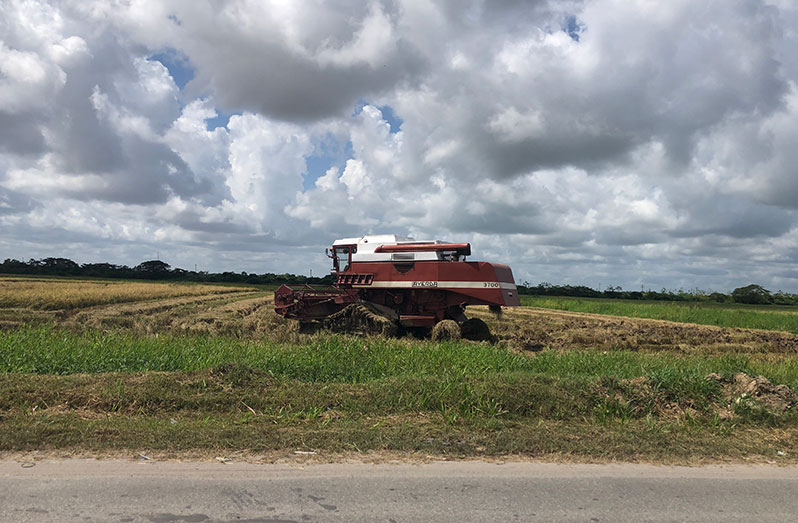–increase of one million bags of paddy projected by 2025
AS Guyana prepares to become a global powerhouse in energy and food production, the government is looking to significantly expand rice production, particularly in Region Three, Essequibo Islands-West Demerara. According to a document provided by Minister of Agriculture, Zulfikar Mustapha, authorities are eying a massive increase of one million bags of paddy, at least by 2025.
This scale up, according to the minister, is being accommodated by way of a number of investments, which have already come on stream, and have begun to bear fruit. These include the reduction in ferry charges to transport paddy from the island of Wakenaam to Parika from $550 to $80 per bag; allowing transportation payments on credit terms; ensuring that farmers transporting paddy from Parika to Leguan island can return for free; increased seed paddy availability to farmers from 1,636 bags to 2,067 bags; the introduction of new paddy varieties, such as the GRBD 16 which currently occupies 21 per cent of the region’s rice acreage; as well as the construction of a drying floor at Wakenaam, among others.

The region, according to Minister Mustapha’s document, has also benefitted from a bio-fortified trial done at Den Amstel, West Coast Demerara; the cleaning of most drainage and irrigation canals, the expansion of the Guyana Rice Development Board’s (GRDB) sub office at Crane, also on the West Coast of Demerara; decentralised seed growers, which increased from 38 acres to 71, as well as the provision of key machinery such as excavators.
Within the coming years, the Agriculture Ministry, via the GRDB is hoping to see significant increases in the overall rice production in Region Three. In addition to the one-million-bag scale up, the rice board projects that by 2025, the GRDB 16 variety would be occupying approximately 70 per cent of the region’s rice acreage, and that yields would increase to approximately 6.4 tonnes per hectare.
It hopes too to complete mapping of all rice cultivation areas in the region; improve rice data management system by providing real time data to farmers; ensuring that all farmers adopt improved agronomic practice; construct all-weather roads in all major rice producing areas within the region; establish a seed-cleaning facility to enhance quality seed; construct drying floor; develop a main canal to connect the conservancy to the Atlantic Ocean, so as to minimise possibilities of flooding. Additionally, the ministry wants to advance its usage of drones for pest management.
As it is, Guyana’s rice industry remains among the leading income earners, raking in some US$123,023,868 (G$25.7 billion) from the export of paddy, rice and rice by-products between January and June 2021, alone. Minister Mustapha had said that these earnings, which resulted from the production of 280,878 tonnes of paddy, represent an improvement when compared to the corresponding period last year, which saw the exportation of 242,000 tonnes of paddy, rice and rice by-products, resulting in earnings that totalled US$99 million.
For the entire 2020, the rice industry raked in US$236.2 million (G$51 billion), as a result of exportation of 574,312 tonnes of paddy, rice, and its by-products
Even as Guyana looks to double its rice production, the events of 2021, particularly the devastating April-May floods, pose a minor challenge. However, Minister Mustapha had said that significant efforts have gone into minimising losses and ensuring that farmers are able to return to their fields and get back into production.
The most impactful of these efforts has been the distribution of flood relief grants which have already seen thousands of farmers in all sectors benefitting from $7.8 billion in direct financial injections. With the majority of rice farmers having returned to the fields, Minister Mustapha had said that he was not expecting any substantial dip in the industry. He noted, however, “We still have to wait and see at the end of it all.”
Harvesting has already commenced in some areas, more notably, Region Two, Pomeroon-Supenaam, and once this wraps up, the Agriculture Ministry would be able to ascertain whether the impacts of this year’s floods would have caused any considerable losses for the industry. Rice Farmers in Regions Five (Demerara-Mahaica) and Six (East Berbice-Corentyne) have borne the brunt of the floods which lasted for more than 60 days in some areas.
Nonetheless, as far as this year goes, Guyana is still hoping to be able to export some 649,480 tonnes of paddy, rice and its by-products, to the value of close to US$257.3 million.
Head of the Guyana Rice Development Board, Kuldip Ragnauth had previously shared the view that rice farmers are incredibly resilient and resourceful people who will be able to weather the storm, and get back up on their feet.




.png)









